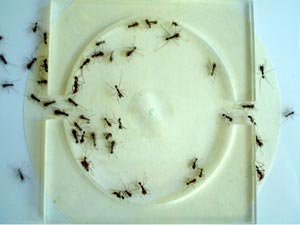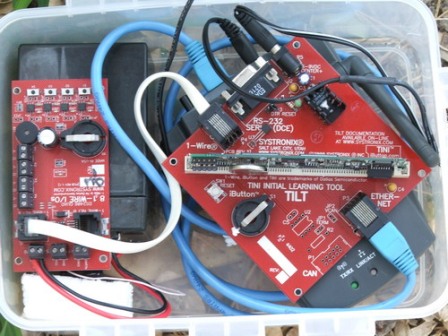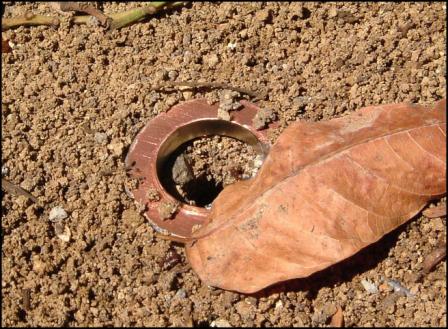Dynamics of Social Insects
 |
by C. Noda and E. Altshuler
Ants, as social insects, are not very wise at the individual level, but collectively they can be quite smart, at least regarding "survival tasks" such as foraging and nest construction. “Self organization” is the keyword here, and it works so nicely that engineers are seriously considering the use of ants strategies to design herds of robots that work cooperatively.

Symmetry breaking in escaping ants
We have been studying rarely explored sides of ants behavior, such as the dynamics of a crowd of ants inside a cell with two symmetrical exits when they are in panic. Our experiments and simulations show that, when in panic, ants tend to use more one exit than the other, due to a "follow-the-crowd" rule of behavior apparently written in their genes. So, when in panic, ants somehow resemble humans. You can download our paper on the subject, which has been featured by The American Naturalist in their December 2005 issue (electronic version). Discover Magazine has also commented our results in a cute report that can be reached here.
Wireless Sensor Networks ( WSN ): A new avenue to probe Social Insects
Of course, efficient traffic related to foraging or nest construction is one of the most interesting features of ants. But quantifying ants' traffic –particularly in the wild– turns out to be too much a challenge for the naked eye. We are starting a project to measure ants “activity” (roughly defined as the number of ants getting in or out a nest's door per unit time) with the help of ad hoc sensors to be integrated into a WSN node. Some preliminary results can be seen in our preprint . We plan to simultaneously measure the activities at several doors, and then calculate the correlation functions, as a novel tool to study the dynamics of Social Insects. The results would be compared to theoretical models we are developing at the time.

We have earlier employed a small embedded computer, called SNAP (for Small Network Application Platform). This computer deployed in the field is wired to the activity sensors collocated at the entry of the nests. These sensors sample temperature, daylight intensity and "activity" on several nest entries. A small Java program running on the SNAP collects all the data and upload it to our servers. The measuring system relies in a Wi-Fi link to connect to the campus network. The instrumentation part of this work is described in this paper published by RSI (also here). You would find the work commented in this article at optics.org.

We conducted our experiments with ants of the species Atta Insularis, wich is endemic of Cuba. Our preliminary results suggest that our system might transform the way to study social insects in the wild.

While the sensor originally designed by us to measure the activity is an optical one, we currently devise capacitive sensors that should improve resolution and consume much less energy. A WSN node that incorporates such sensor will allow us to study in full detail the traffic of ants in ant trails, looking for analogies with highway traffic of cars.
| "Henri Poincare" Complex
System Group- Contact us |